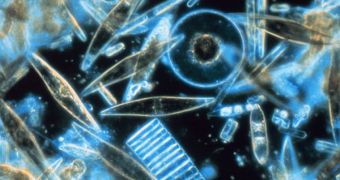As the world's oceans are bound to become more acidic than ever before, researchers are gearing up to face the consequences by trying to understand what the effects of this process will be. Analyzing organisms known as coccolithophores might help in this regard, a new study shows.
The organisms have the tendency to produce coccoliths, which are in fact tiny calcite plates. The mineral, also known as calcium carbonate, is the main ingredient making up chalk, experts say.
As a type of phytoplankton, coccolithophores are much smaller than the width of the human hair. Studies have shown that they produce coccoliths as part of their intricate spherical housings.
Analysis of ancient chalk deposits, such as the 65-million-years-old White Cliffs of Dover, in England, are now carried out by experts, who hope to obtain a better understanding of how the oceans will react to acidification.
What is interesting about the coccoliths at this UK location is the fact that they did not dissolve and recrystallize into larger clumps, as it usually happens with these minerals. Rather, they remained of microscopic size, which means that they may have something special.
A team at the University of Copenhagen is now investigating these deposits, in order to determine what is it that makes the Dover calcite so special. New data on these minerals could help the scientific community determine how phytoplankton will respond to acidification.
This process takes place as waters try to capture more and more carbon dioxide from the Earth's atmosphere. The process leads to the synthesis of the compound carbonic acid, which then goes on to reduce the pH levels. A lower pH indicates acidic waters, while higher pH levels indicate alkaline ones.
In a series of advanced studies, the Copenhagen team was able to accurately measure the mass of individual coccoliths within a margin of error of less than one trillionth of a gram, Wired reports.
The inorganic calcite crystals started to dissolve at around pH 8.2, while the studied cocoliths managed to resist dissolution until pH 7.8. This means the latter withstand acidity better.
According to the investigators, this difference in resistance may be provided by the addition of the organic, single-celled microorganism living inside each coccolith. The finding is interesting especially when comparing the types of calcite several phytoplankton organisms produce.
Some shells are for example made out of aragonite, which dissolves in acidic environments a lot faster than calcite. This implies that some species of phytoplankton will be more devastated than others by lower-pH oceans.
Understanding what will happen to these organisms is essential because the entire food web permeating the oceans is based on them. Without phytoplankton, the webs will collapse, leading to decline in fisheries, and threatening our food supplies.

 14 DAY TRIAL //
14 DAY TRIAL //